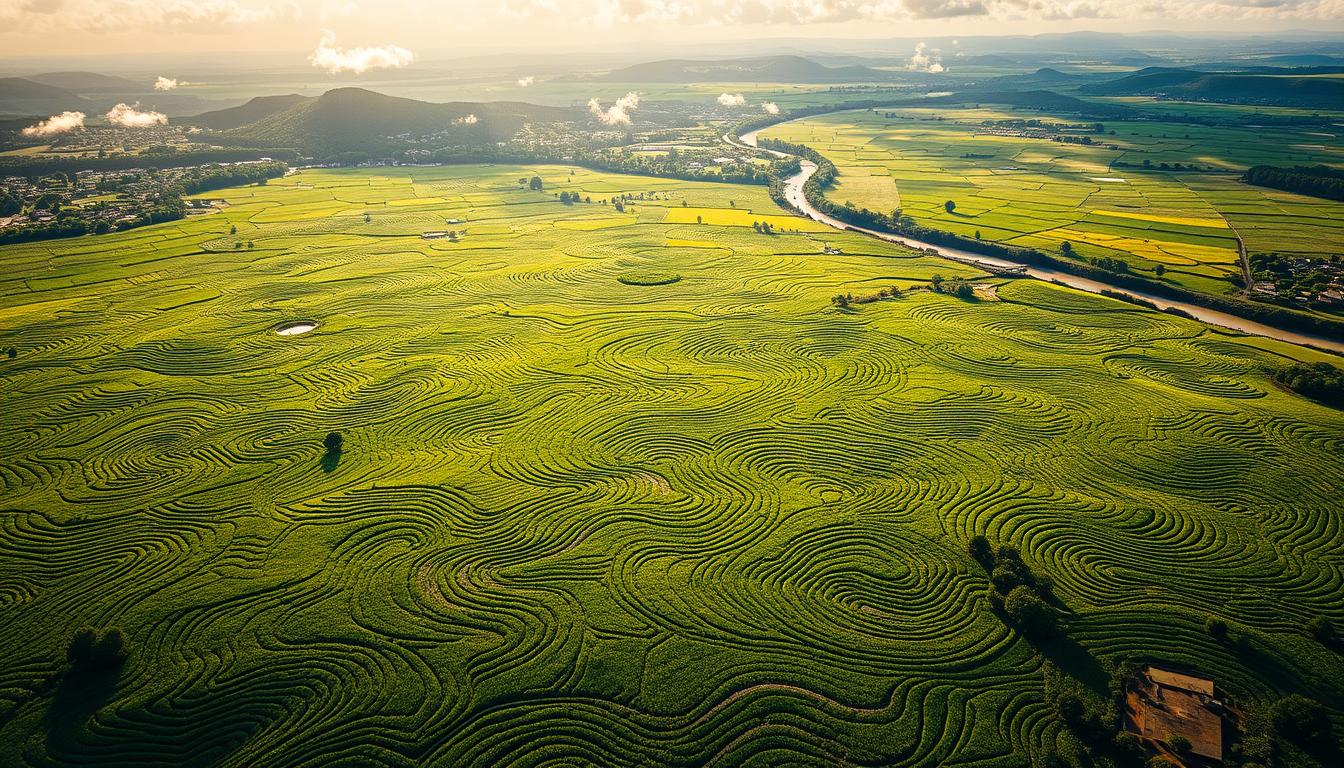Fractal patterns are key in weather forecasting and climate modeling. They reflect the complexity in nature, boosting predictive accuracy. By tapping into chaos theory, experts see weather’s fractal nature clearer.
This insight helps forecasters predict weather and climate changes better.
Studying fractals helps scientists model climate system interactions. This leads to stronger models that show how chaos and fractals impact weather and climate. Exploring these connections shows how we can improve forecasting.
Introduction to Fractals in Nature
Fractals show us how patterns repeat in nature, from tiny to huge scales. They are found in many natural forms, showing nature’s geometry. These patterns, seen in tree branches or cloud formations, highlight earth’s complex systems.
Fractals appear in both living things and the earth’s physical features. They are seen in mountains and rivers, showing how chaos creates order. The way coastlines look or how leaves spread out are examples of fractal designs.

Learning about fractals helps us better understand our world. It sheds light on how life and earth are interconnected. This shows that there’s a hidden order in what seems random, making fractals vital in our environment.
The Complexity of Weather Patterns
Weather patterns are complex and are driven by many factors, especially the systems around clouds. These phenomena are always changing. They respond to both nearby and worldwide conditions. Understanding clouds helps us grasp the complexity of weather. Clouds show us when the atmosphere is changing. How they form and disappear can bigly change weather forecasts.
Understanding Clouds as Dynamic Systems
Clouds are crucial for weather systems. They are not still but change often due to environmental changes. They might grow, vanish, or change shape quickly, because of temperature, moisture, and air pressure. This makes predicting the weather hard for weather experts.
The Role of Chaotic Behaviors in Weather Prediction
Chaos theory shows that weather is hard to predict. Ed Lorenz found that small changes can make weather forecasts vary a lot. Knowing more about chaos helps improve weather models. This knowledge lets scientists expect changes in weather, making forecasts more accurate, despite the difficulties.
Fractal Patterns in Weather Forecasting and Climate Modeling
Fractals are crucial in understanding weather. They offer unique insights into weather patterns. The way weather systems behave can often be explained with fractals. These patterns repeat on many scales. This helps make weather forecasts more accurate and improves math models.
Defining Fractals in Meteorological Context
Fractals in weather include patterns seen in clouds and how rain is spread out. These fractals look similar up close or far away. Meteorologists use them to understand how different weather parts connect. This makes weather forecasts more reliable.
Mathematical Foundations and Applications
Forecasters use complex math to model weather fractals. This lets them predict weather patterns more accurately. Fractal geometry helps study complex air patterns and weather events. It’s used in a few key ways:
- Enhancing radar imagery interpretation
- Improving storm tracking and prediction
- Modeling chaotic systems typically found in climate dynamics
Using fractals helps improve how we predict the weather. It adds to the traditional methods, making forecasts better.
Historical Perspectives on Weather Forecasting
The history of weather forecasting is filled with innovations. Pioneering figures, like Lewis Fry Richardson, played vital roles in advancing our knowledge of the weather. Richardson’s work led to the development of the advanced predictive models we use nowadays.
Contributions of Lewis Fry Richardson
In the early 20th century, Lewis Fry Richardson, a mathematician and physicist, introduced numerical weather prediction. He believed that the atmosphere’s behavior could be explained by simple mathematical laws. This idea was the foundation for modern meteorology. Richardson’s book, “Weather Prediction by Numerical Process,” showed how equations could forecast weather. Although his time’s technology limited his work’s practical use, his theories inspired a new focus on quantitative meteorology.
The Evolution of Predictive Models Over Time
Since Richardson, predictive models have evolved from basic theories to complex computer algorithms. Initially, forecasts depended on observations and statistics. As technology improved, simulation and modeling became key in weather forecasting. Nowadays, meteorologists use detailed models that consider a wide range of data for making predictions. This change has greatly improved how we predict weather patterns.
Deterministic Chaos and the Butterfly Effect
Weather forecasting is heavily influenced by deterministic chaos. It shapes our understanding of climate systems. The butterfly effect shows how small changes can make big differences in weather outcomes. It means even slight variations can cause large changes in the atmosphere. Thus, making accurate predictions is really tough.
Impact on Long-term Weather Predictions
Long-term weather forecasting is hard because of deterministic chaos. Even tiny changes in things like temperature can lead to different weather. Meteorologists are working hard to make their forecasts more reliable. They do this by considering these uncertainties in their models.
Scale and Measurement Challenges
Scientists find it tough to measure things accurately in chaotic systems. When they try to measure on a big scale, they find differences that make accuracy harder. Their weather models must use strong methods to deal with these challenges. They also have to remember that these systems are unpredictable.
Using Fractals to Model Climate Change
Fractals give us a deep look into climate change’s complex nature. They show how clouds, which heavily affect climate systems, behave. Clouds can make global warming’s effects stronger or weaker, making them key in predicting our climate’s future.
Clouds: A Variable in Climate Models
Adding clouds to climate models is tough because they change a lot. They react to many environmental factors, causing unpredictable outcomes. Understanding how clouds impact global temperature is vital.
As our climate changes, the way clouds vary becomes more important. This makes predicting the future climate even harder.
The Uncertainties of Predicting Ice Sheet Dynamics
Ice sheets are another uncertain area in climate modeling. How they respond to climate changes is hard for scientists to figure out. The mix of temperature changes and ice sheet stability creates big prediction challenges.
It’s crucial we get better at predicting how ice sheets will behave. This helps improve models that predict our planet’s climate future.
The Interplay Between Ocean Currents and Weather Systems
Ocean currents greatly influence the weather worldwide. They determine the atmospheric patterns, affecting temperatures and storms. The relationship between the ocean and the atmosphere is intricate.
Understanding Rogue Waves and Their Implications
Rogue waves are unexpectedly large and powerful, posing dangers to ships. They are caused by ocean currents affecting wave growth. When rogue waves form, they can disrupt shipping lanes and endanger marine activities.
The Role of Ocean Temperature in Climate Models
Ocean temperature is vital for climate projection models. It shapes precipitation and storm severity. Changes in ocean temperature affect global weather patterns. Thus, measuring ocean temperature accurately is crucial for forecasting climate changes.
The Future of Weather Forecasting
Weather forecasting is getting better thanks to new tech and more computing power. These improvements will make weather predictions more accurate and faster. Experts are using deep tech analysis to understand weather better, with fractal analysis being a key tool.
Advancements in Technology and Computational Power
New technology and powerful computers help improve forecasting. Meteorologists now analyze lots of data quickly. This means they can make better predictions by noticing small changes in the weather.
Thanks to strong algorithms, forecasts are more detailed and trustworthy.
Integrating Fractal Analysis in Modern Forecasting
Fractal analysis is changing how we handle weather forecasts. It helps make sense of complex and changing weather patterns. With it, forecasters see weather in new ways, finding patterns we missed before.
This method makes predicting the weather more accurate. Fractal analysis is a big step towards better forecasting.
Sustainability and Environmental Implications
Understanding how our climate works is key to sustainability. It helps us see the environmental effects of our actions. With reliable forecasts, communities and leaders can create plans to lessen climate change’s impact. Adding fractal patterns to these models helps us better understand weather, making us ready for severe conditions.
The Importance of Accurate Climate Modeling
Knowing what the weather will do is crucial for dealing with climate shifts. When models use fractal patterns, they predict weather changes like temperature and rain more accurately. This info helps us act sustainably and keeps communities safe from climate problems.
Preparing for Extreme Weather Events
Extreme weather is happening more often and is more severe. Accurate weather forecasts let us get ready for events like hurricanes and droughts. This link between knowing the climate and being sustainable means we can plan better for emergencies. Being proactive saves lives, helps the environment, and supports sustainability.
Conclusion
This exploration shows how fractal patterns are key to better weather forecasts and climate models. Understanding these complex patterns helps us see that using fractals can make predictions more accurate. They give us a peek into the unpredictable ways of weather, helping scientists expect changes around us.
Using fractal analysis in forecasting and modeling is vital for tackling future climate issues. Thanks to tech and computing advances, we now have better tools for this task. This means we can better prepare for extreme weather, which is more than a scientific win. It’s a step towards living better with our changing climate.
In the end, this article makes one thing clear: fractals are crucial for our climate knowledge and predictions. With the climate and weather becoming harder to predict, fractal analysis is key. It will help us find our way as we deal with our planet’s future challenges.



